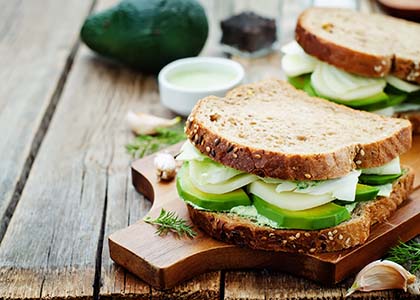
Pack the Perfect Lunch Box
By Isabel Smith, MS, RD, CDN
It’s September and I don’t know about you, but I’ve certainly got that “back to school” feeling. The weather is changing, school supplies are lining store shelves and parents are shopping for snacks to fill their kids’ lunch boxes. And guess what? It’s the perfect time to start thinking about what’s going into your lunch box too. Lunch is such an important part of our day, it’s the meal that we finish feeling either powerful or powerless for the duration of the afternoon. So we need to give it the attention it deserves.
To help you blast into fall loaded with energy, try using these tips when you prepare your next lunch box meal.
5 tips for building your healthiest lunch box:
1. Lose the plastic.
Plastics can be so bad for so many reasons, but particularly because when heated (ahem, heating and re-heating or dishwasher) the integrity of the plastic can be altered, making it easier for the plastic to leach out into the food we’re eating. Here are 13 reasons to pass on plastic.
2. Load up on the plant foods.
This is of course what every dietitian recommends – to eat more vegetables, right? It’s true, but I often find that it’s an empty statement because there may not be tangible and tasty recommendations to follow. So here are a few ways to include more vegetables and nutrient-packed plant foods into your lunch:
Use homemade pesto or hummus on your salad or sandwich
Add more greens to your sandwich and think beyond green leaf lettuce — try arugula, spinach or even kale
Pack a hearty-soup; soups are so easy to load with vegetables and can be a hit even for the person who doesn’t really love veggies; this budget-friendly cauliflower soup is one of my favorites
Make a fresh salad dressing instead of purchasing a pre-made and processed dressing; try making this healthy carrot and ginger salad dressing that adds extra nutrients
Stick to whole grains whenever possible; this includes opting for quinoa, brown rice, whole grain breads, pastas or flours when making sandwiches, or when adding grains to salads, choosing pastas or other bread products
Look for basic staples like ketchup, mustards, mayonnaise and other spreads without added and artificial ingredients
3. Don’t forget the protein.
Protein can help you feel fuller for longer, which also means more energy too. Include ingredients like plant-based organic/non-GMO protein including tofu, or lean and organic/wild poultry, eggs, fish or beef into your lunch. At the very least, if a protein-packed item isn’t on your ingredient list, choose one with healthy fat like hummus, beans, avocado or nuts. The healthy fat will also help to promote satiety. To get more ideas for lunch, here are 18 plant-based sources of protein.
4. Skip the sugary drinks.
Just do yourself a favor and skip these drinks altogether because it’s a quick way to save calories and sugar as well as artificial ingredients that don’t serve us a purpose. Instead, go for regular filtered water, coconut water (unflavored) or naturally infused water using your favorite fruit or vegetables (pineapple, cucumber, oranges, lemons, etc.).
5. Pack a snack for later.
Although what you bring for lunch is key, your mid afternoon snack is also crucial. We should be aiming to eat every 2-3 hours for the most part, which means lunch at 12 or 1 pm won’t get you all the way through until dinner. Choose a snack with fiber, healthy fat, or protein to help you stay fuller for longer.
Here’s a few good examples of lunches and lunch options to pack in your lunchbox:
Main entrée ideas:
Snack ideas for the lunchbox/bag:
- Sliced vegetables
- Piece of fruit
- Nuts
- Organic dairy-free or regular yogurt (unflavored)
- Raw Veggie Flax Crackers
- Herbed popcorn
Healthier dessert ideas: